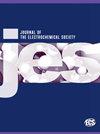Deciphering the Role of p-Type ZnCo2O4 Semiconductor Nanoflakes for Selective Enhancement of Voltammetric Responses Toward Redox Species System: Interfacial Electron-Transfer Kinetics and Adsorption Capacity
IF 3.3
4区 工程技术
Q2 ELECTROCHEMISTRY
引用次数: 0
Abstract
In this study, we describe experimental efforts to decipher the role of ZnCo2O4 nanoflakes (ZCO-NFs) for selective enhancement of voltammetric responses of screen-printed electrode (SPE) toward redox species system. The ZCO-NFs sample was characterized by X-ray diffraction (XRD), Raman spectroscopy, scanning electron microscopy (SEM) and UV–vis spectroscopy. The electrochemical characterization of bare SPE and modified SPE electrodes was investigated by cyclic voltammetry (CV), electrochemical impedance spectroscopy (EIS) and Mott−Schottky analysis. A series of redox systems including paracetamol (PA), dopamine (DA), chloramphenicol (CAP), furazolidone (FZD), p-nitrophenol (p-NP), carbaryl (CBR), ofloxacin (OXF), and erythromycin (ERY) were selected to investigate for (i) reversible redox process, (ii) irreversible electrochemical oxidation process, and (iii) irreversible electrochemical reduction process on both bare-SPE and ZCO-NFs/SPE electrodes. The obtained results showed that ZCO-NFs possess the selective enhancement of electrochemical response for redox systems with an increase of 24%–90% for PAR, DA, FZD, CAP, and CBR and a decrease of 13%–49% for p-NP, ERY, and OFX. The different electrochemical response of redox species at nanostructured semiconductor electrodes is attributed to the contribution of both the adsorption capacity of redox species and the interfacial electron transfer process between electrode and redox species. An insight into the interfacial electron transfer kinetics and its contribution to the enhancement of electrochemical response on p-type semiconductor electrode is helpful in designing high-performance sensing platforms based on spinel oxide nanostructures.解密 p 型 ZnCo2O4 半导体纳米片在选择性增强氧化还原物种系统伏安反应中的作用:界面电子转移动力学和吸附容量
在本研究中,我们介绍了为破译 ZnCo2O4 纳米片(ZCO-NFs)在选择性增强丝网印刷电极(SPE)对氧化还原物种系统的伏安响应方面的作用所做的实验工作。ZCO-NFs 样品通过 X 射线衍射 (XRD)、拉曼光谱、扫描电子显微镜 (SEM) 和紫外可见光谱进行表征。通过循环伏安法(CV)、电化学阻抗光谱法(EIS)和 Mott-Schottky 分析法研究了裸 SPE 和改性 SPE 电极的电化学特性。一系列氧化还原体系包括扑热息痛(PA)、多巴胺(DA)、氯霉素(CAP)、呋喃唑酮(FZD)、对硝基苯酚(p-NP)、西维因(CBR)、氧氟沙星(OXF)和红霉素(OXF)、和红霉素(ERY),研究它们在裸 SPE 和 ZCO-NFs/SPE 电极上的 (i) 可逆氧化还原过程、(ii) 不可逆电化学氧化过程和 (iii) 不可逆电化学还原过程。研究结果表明,ZCO-NFs 可选择性地增强氧化还原体系的电化学响应,对 PAR、DA、FZD、CAP 和 CBR 的增强率为 24%-90%,对 p-NP、ERY 和 OFX 的增强率为 13%-49%。氧化还原物种在纳米结构半导体电极上的不同电化学反应归因于氧化还原物种的吸附能力以及电极与氧化还原物种之间的界面电子转移过程。深入了解界面电子转移动力学及其对提高 p 型半导体电极电化学响应的贡献有助于设计基于尖晶石氧化物纳米结构的高性能传感平台。
本文章由计算机程序翻译,如有差异,请以英文原文为准。
求助全文
约1分钟内获得全文
求助全文
来源期刊
CiteScore
7.20
自引率
12.80%
发文量
1369
审稿时长
1.5 months
期刊介绍:
The Journal of The Electrochemical Society (JES) is the leader in the field of solid-state and electrochemical science and technology. This peer-reviewed journal publishes an average of 450 pages of 70 articles each month. Articles are posted online, with a monthly paper edition following electronic publication. The ECS membership benefits package includes access to the electronic edition of this journal.

 求助内容:
求助内容: 应助结果提醒方式:
应助结果提醒方式:


